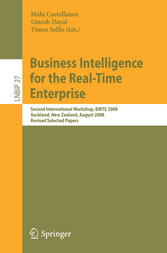Suchen und Finden
Mehr zum Inhalt

Business Intelligence for the Real-Time Enterprise - Second International Workshop, BIRTE 2008, Auckland, New Zealand, August 24, 2008, Revised Selected Papers
Title Page
2
Preface
5
Organization
7
Table of Contents
8
Situational Business Intelligence
9
Introduction
9
Situational Business Intelligence
11
Example Scenario
11
Answering SBI Queries
12
Building a SBI System
13
Architecture and Components
13
Research Challenges
16
Related Work
17
Conclusion
18
References
18
On Solving Efficiently the View Selection Problem under Bag-Semantics
20
Introduction
20
Related Work
22
Preliminaries
23
Basic Definitions
23
Query Rewriting and the View Selection Problem
24
The Space of Optimal Solutions
26
Representative Set of Solutions
26
LGG-VSB Algorithm
31
Chain and Path Queries
32
Chain-Query Workload
32
Path-Query Workload
34
Conclusion
34
QoS-Aware Publish-Subscribe Service for Real-Time Data Acquisition
37
Introduction
37
Background
39
Overview of $Agilor$
39
Conceptual Model of $DDS$
40
Supported QoS of $DDS$
41
Real-Time ECA
41
Event
42
Condition
44
Action
44
Coupling Modes
44
Semantic for $RECA Rules$
45
Case Study
45
Related Data Structures
46
QoS Policies Settings of Each Entity
47
Translating QoS Settings to $RECA$
50
Limitations of Triggered Rules
50
Conclusions and Future Work
50
A Near Real-Time Reporting System for Enterprises Using JavaScript Instrumentation with Inter-colo Event Replication
53
Introduction
53
Past BI Pipeline Architecture
54
Past Instrumentation Techniques
55
New Architecture
56
Instrumentation
58
Implementation of Library
59
Implicitly Collected Data
60
Instrumentation Generation
60
Validation of Instrumentation
60
Data Collection
61
In-Colo Collection of Real-Time Data
63
Centralized Collection of Real-Time Data
64
Data Filtering
64
Reporting and Visualization
64
Example Use Case
66
Results and Conclusion
67
A Hybrid Row-Column OLTP Database Architecture for Operational Reporting
69
Introduction
69
Column Databases
70
A Hybrid Architecture for Operational Reporting
73
Necessity of Operational Reporting
73
Architecture
73
Virtual Cube
75
Related Work
77
Common Data Warehouse Architectures
77
Latency-Reduced Reporting Architectures
78
Conclusions
79
Future Work
80
The Reality of Real-Time Business Intelligence
83
Introduction
83
The Origins of Business Intelligence
84
The Early Years (1970s – 1980s)
86
Data Warehousing (1990s – )
87
Emergence of Business Intelligence (2000–)
90
Real-Time Business Intelligence
92
Concluding Remarks
95
Beyond Conventional Data Warehousing — Massively Parallel Data Processing with Greenplum Database (Invited Talk)
97
Introduction
97
Explosive Data Growth
98
A New Kind of Database System
99
Alternate Application Areas
100
Beyond Conventional Data Warehousing
101
Declarative Programming Models
101
Other Programming Models
101
MapReduce
102
Cost of Data Transfer
102
Future Trends and Challenges
102
Analytics
102
Hardware Developments
103
Database Technology and Programming Paradigms
103
Summary
103
Scalable Data-Intensive Analytics
105
Introduction
105
The Challenges
106
The Research Directions
107
Extend UDFs to Support Parallel Processing
108
K-Means Clustering Algorithm
108
K-Means Using Relation Valued Function
109
K-Means in MapReduce Style on Parallel DB
110
SQL Query Process
111
Handle Enterprise Dataflow Inside Database Engine
111
Correlated Query Process with RVF
112
Data Continuous Query Process
113
Implementation Issues
114
Conclusions
115
References
115
Simplifying Information Integration: Object-Based Flow-of-Mappings Framework for Integration
116
Introduction
116
Unified Famous Objects (UFOs)
120
Schema Decomposition
122
An Overview of the Technique
123
Orchestrating Flows of Schema Mappings
124
Unified Flow Model Framework
126
Conclusion
128
Author Index
130
Alle Preise verstehen sich inklusive der gesetzlichen MwSt.








